Introduction
The field of e-commerce has been coming more and more popular in recent years. According to Stair et al. (2018), by e-commerce, we understand the realization of business transactions (e.g.: distribution, purchase, sale, and services) electronically using a computer network. The development of e-commerce was driven by various global and technological aspects. One of them was the development of high-speed Internet connection, which enabled even small businesses to access global markets (Chrysostome and Rosson, 2009). This trend is also confirmed by the available global data on retail sales in recent years in the field of e-commerce, where in 2015 sales were at the level of 1.5 billion USD, in 2018 they doubled to almost 3 billion USD, while this trend was amplified due to the COVID19 pandemic, where total sales in 2021 reached almost 5 billion USD (which is more than triple since 2015). The forecast for the future predicts the continuation of similar growth. (Statista, 2022). Recent years have not only brought rapid growth but also several threats in connection with recent events in the world, such as disruption in supply chains during the COVID19 pandemic (Bravo et al., 2022) and due to recent security and political events in the world.
Sales’ increases in e-commerce are mainly due to consumer behavior, which we analyzed in more detail in connection with the COVID19 pandemic in our previous research (Černý et al., 2021). Our main findings were that young people under the age of 25 either shop online or combine online shopping with brick-and-mortar shopping and they are aware of the benefits of online shopping. Because of the COVID19 pandemic in the last few years, people in Slovakia, as in other countries, spent more time online (Hashem, 2020; Sayyida, Hartini, Gunawan, Husin, 2021). They were engaged in surfing on the Internet, online shopping, entertainment through websites, and searching and tracking health information. They also plan to increase their online activities in the future (Koch, Frommeyer, Schewe, 2020).
The aim of this paper is to determine the factors influencing certain aspects of consumer behavior when shopping on the Internet. Specifically, we want to focus on two areas of consumer behavior when shopping online, namely the area of reputation management, more closely determined by customer reviews, and in the second model, the advantages of shopping online compared to shopping in a brick-and-mortar store. Therefore, our first partial aim is to examine determinants that influence whether the consumer considers the reviews of other customers to be important for his purchase decision, or unimportant. Our second aim is to investigate the factors that influence the choice of whether the respondent considers the more important benefits of online shopping to be of a financial nature (i.e., mainly a lower price) or a non-financial nature (e.g., convenience, selection, unique offerings, time-saving).
Literature Review
We will understand reputation management as the practice of influencing stakeholder perceptions and public conversations about an organization and its brands. It’s including communication, marketing, legal, customer experiences, and sales and loyalty. (Gartner, 2022). Customer reviews are part of reputation management in e-commerce or other electronic channels. According to Ma and Bai (2020), and other studies, it is becoming apparent that there is a significant relationship between online reviews, customer decision-making, and sales (in the retail and service sector). For many e-commerce businesses, securing top review ratings (on a scale of 1-5, where 5 is the best; in the range of 4-5) is essential to survival (Rose and Blodgett, 2016). Many consumers shopping online look for positive or negative online reviews that contain the experiences of other customers with the use of a given product/service. Online reviews help potential buyers because they contain information that supports the buyer’s trust in purchasing a product/service (Moriuchi, E., 2018). Many authors have addressed the importance of reviews in influencing consumers’ purchasing behavior in online shopping. We selected relevant authors and their works in tab. 1.
Table 1: Customers Reviews Importance in e-Commerce – Literature Review
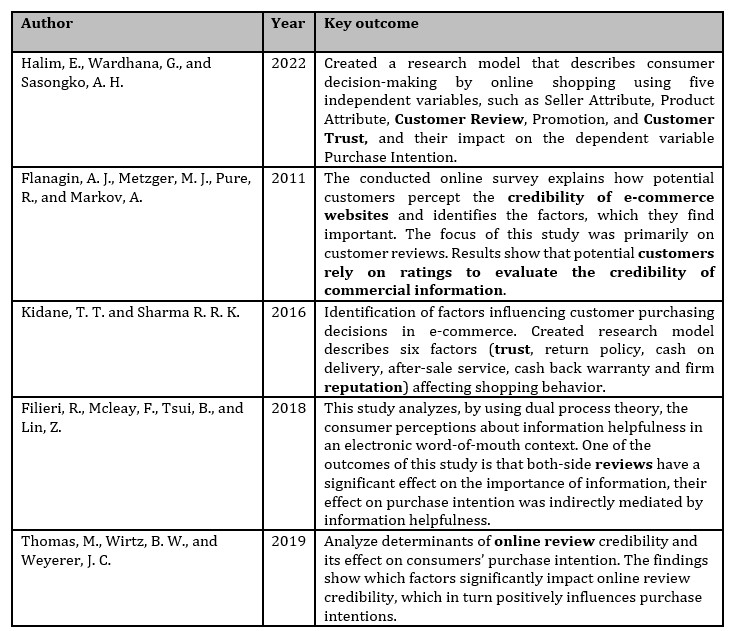
(Source: prepared by authors)
Based on the mentioned studies and research, it is possible to conclude a significant influence of reviews on the Internet on the purchasing behavior of consumers. In our analysis, we will focus on finding out the factors that determine whether consumers will consider reviews important or vice versa.
Many factors influence consumer behavior when shopping online. Many studies and authors analyze these factors (Moon, Choe, Song, 2021; Odilia, Sulistiobudi, Fitriana, 2022), some of them we already mentioned. We will focus on the financial and non-financial benefits of online shopping, how consumers’ perception of these benefits affects their future purchasing decisions, and what determinants influence whether consumers will prefer the financial or non-financial benefits of shopping on the Internet.
Table 2: e-Commerce Benefits for the Customer – Literature Review
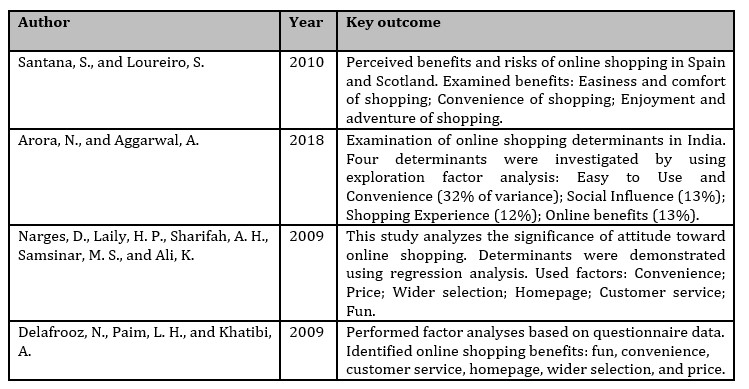
(Source: prepared by authors)
Many studies (e.g., Childers, 2001) dealing with the consumer’s purchasing motives divide them into functional (price, convenience, etc.) and non-functional (hedonic – related to social background and emotional state). According to Forsythe et. al. and other studies, functional motives are: convenience, selection, unique offerings, time-saving, and lower price. According to our literature review, there exist many studies dedicated to the benefits and risks of online shopping, from all we selected a few in tab. 2.
In this study, we group functional motives – benefits into two categories: financial (lower prices) and non-financial (all others).
Research Framework and Methodology
The goal of this paper is to determine the factors influencing certain aspects of consumer behavior when shopping on the Internet by using the logistic regression method.
Table 3: Independent Variable Overview
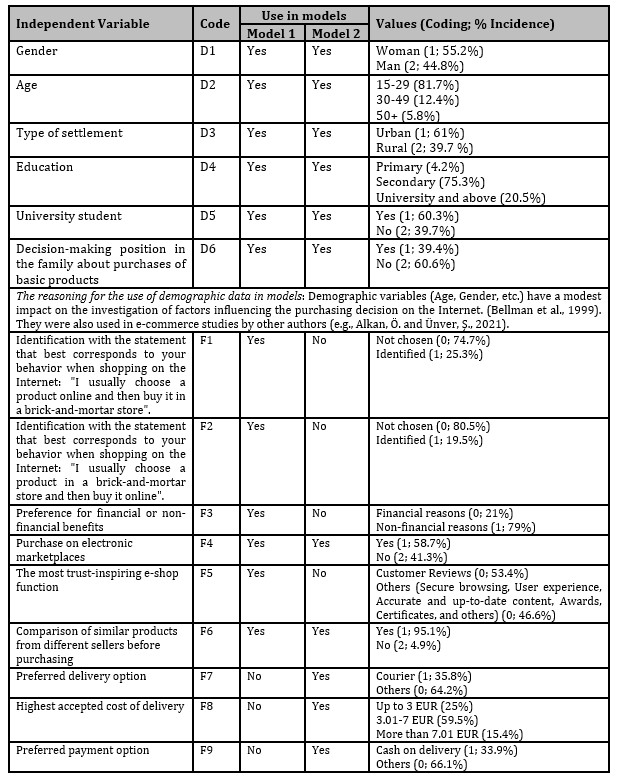
(Source: prepared by authors)
In our research, we will focus on examining the determinants that influence whether the consumer considers the reviews of other customers to be important for his purchase decision, or unimportant. We present the mentioned model in fig. 1.
In the second research model, shown in fig. 2, we focus on the factors that influence the choice of whether the respondent considers the more important benefits of online shopping to be of a financial nature (i.e., mainly a lower price) or a non-financial nature (e.g., convenience, selection, unique offerings, time-saving).
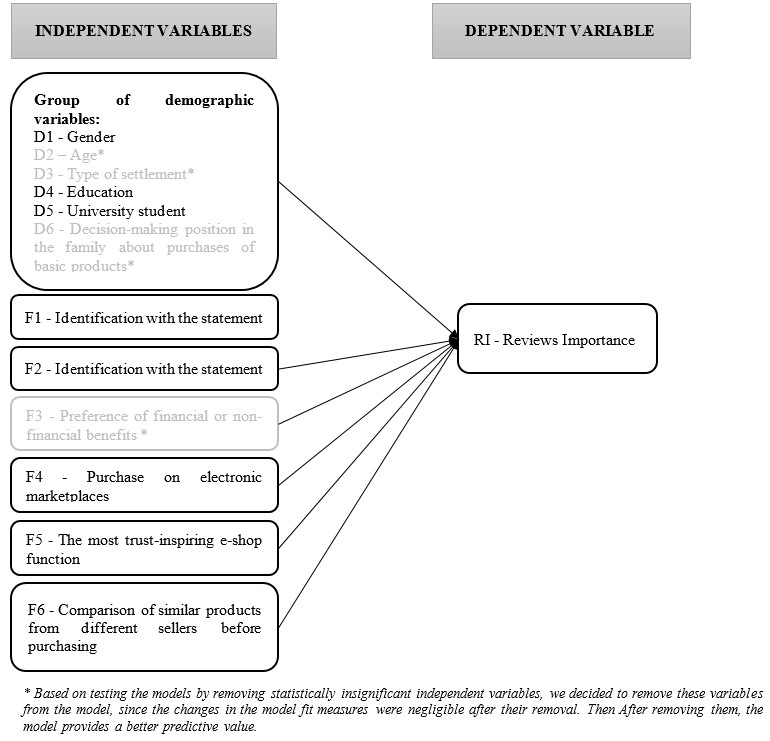
Fig 1: Research Model 1 – Determinants of Reviews Importance
The selection of independent variables in research model 1, which can explain the dependent variable RI – Reviews Importance was based on the following assumptions:
- By factor F1, we assume that those who tend to make a product selection on the Internet and then buy it in a brick-and-mortar store will use more available information sources that the Internet offers in their decision-making and will therefore also use customers’ reviews as a source of information for their purchasing decisions, and are, therefore,
more likely to consider customer reviews as more important. Factor F2
should have a weaker or even opposite effect than the previous factor F1, due to its opposite meaning and preference for choosing a product in a brick-and-mortar store, where it is not possible to see other customer reviews.
- We assume for factor F3 that for those respondents who consider the financial benefits of shopping on the Internet to be the most important, price orientation will prevail in their choice, and other factors, as well as the other customer reviews, will be less important for them.
- Most of the large e-marketplaces are strongly focused on customer reviews and offer them to their customers. We assume that it is more likely that people who shop on e-marketplaces consider customer reviews important.
- We assume that respondents who consider customer reviews as the most trust-inspiring function will be more likely to use customer reviews when making a purchase decision.
- We expect that those who compare similar products from different sellers before purchasing will probably consider the customer reviews to be more important.
Our assumptions for the selection of independent variables in research model 1, which can explain the dependent variable P – Preference for financial or non-financial benefits, are the following:
- For factor F7, we suppose that consumers who choose the delivery method by courier, which is usually the most expensive, but on the other hand also the most convenient delivery method, will probably prefer more non-financial benefits.
- We assume that respondents who are willing to accept a higher maximum shipping price will be less sensitive to price when making a purchase decision and will therefore likely prefer the non-financial benefits of online shopping.
- Cash on delivery is usually the only payment method with an additional fee in Slovakia, and therefore we assume that people who prefer cash on delivery are less sensitive to the price of goods and will therefore prefer non-financial benefits more.
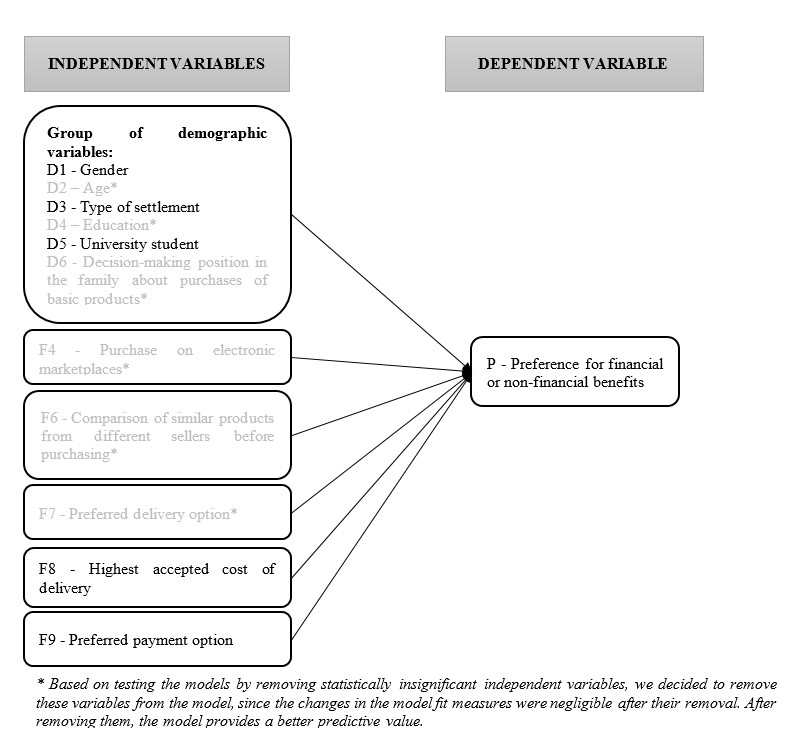
Fig 2: Research Model 2 – Determinants of Reviews’ Importance
The designing of research models was preceded by the analysis of literary sources from the WOS, SCOPUS databases, sources searchable via Google Scholar, and other professional articles available on the Internet.
We selected suitable literary sources from the available options and synthesized them to create a literature review. We used the knowledge acquired from the literary review to research model creation. We have also incorporated knowledge from our previous research (Černý et al., 2021) about the influence of customer behavior on online purchases, where we analyzed two groups of indicators. The first group concerned twelve indicators describing the behavior of consumers when shopping online (identification with statements about typical online shopping behavior, the benefits of shopping online, purchase from a foreign e-shop, purchase on e-marketplaces, the importance of other customer reviews, the credibility of e-shop functions, the untrustworthiness of e-shop functions, reasons to leave the website during the checkout process, comparison of similar products from several manufacturers, preferred delivery method, preferred payment method and categories of products purchased over the Internet). The second group of ten indicators focused on behavioral change due to the COVID19 pandemic (we do not describe them in detail, as they are not important for this article). The mentioned indicators were subsequently characterized based on four descriptive indicators (gender, age, education, and whether the respondent is a university student or not). In previous studies, several of these demographic predictors prove to have an effect (Ameen, Tarhini, Shah, Nusair, 2021; Wijaya, Grace, Candra, Sidabutar, 2022).
Data for the evaluation of the models were collected using an online questionnaire survey on students in the third year of bachelor’s studies, Faculty of Business Management, University of Economics in Bratislava, and their family members and acquaintances. The survey was conducted in the years 2021 and 2022. The sample contains 1318 questionnaires. The questionnaire was created to analyze the behavior, habits, and opinions of students and their surroundings in the field of e-commerce.
We used regression analysis as a statistical method for evaluating the research models, which is a frequently used statistical method for evaluating data in the field of e-commerce (e.g., Narges et. al., 2009; Alkan, Ö. and Ünver, Ş., 2021; Riad, E. and Al Chami, R., 2021, etc.). We performed the calculation in the open-source statistical software JAMOVI. In tab. 3, we present the structure of the research sample, where the used independent variables are listed with information on which research model they were used, what their coding is, and the frequency of occurrence of their values.
The verification of the meaning of the binomial logistic regression analysis on our models will be evaluated based on the overall model test, where the decisive value of p (statistical significance) must be below the value of p < 0.05. We will evaluate the degree of explanation of the dependent variable through the independent variables by using Nagelkerke’s R squared, where the values are in the interval 0 and 1, and the higher value, the better the explanation of the dependent variable. We will evaluate the statistical significance of the influence of individual independent variables based on the omnibus likelihood ratio tests for each variable, and in the case of their value of p < 0.05, we will consider them statistically significant, and we will evaluate their strength of effect on the dependent variable. We will make a basic evaluation of the effect of the independent variable on the dependent variable using the Estimate values (log odds; B -Beta), where we follow the direction of the influence (positive or negative value) and supplement the basic interpretation with the Odds ratio (Exp(B)), where we will be interested in the value higher than 1 (the chances of the occurrence of the phenomenon increase) or lower than 1 (the chances of the occurrence of the phenomenon decrease), or around the value of 1 (in this case, the independent variable would have almost no effect on the dependent variable) (Rabušic et. al., 2019).
Results
We analyzed the influence of the independent variables in model 1 (D1 – Gender, D4 – Education, D5 – University student, F1 – Identification with statement 1, F2 – Identification with statement 2, F4 – Purchase on electronic marketplaces, F5 – The most trust-inspiring e-shop function, F6 – Comparison of similar products from different sellers before purchasing) on the dependent variable importance of customer reviews when making a purchase decision by online shopping. Overall, model 1 test was statistically significant (p < .001), χ² = 147, df = 9. The model explains R squared = 0.196 variability (Nagelkerke).
Table 4: Model 1 Coefficients – Dependent Variable: RI – Reviews Importance

(Source: prepared by authors)
The measured results of the regression analysis for model 1 are shown in tab. 4.; while statistically significant values are highlighted in green, insignificant values are in yellow and red. We will only interpret statistically significant independent variables.
Independent variable D1 – Gender is a statistically significant predictor p < 0.015, odds ratio = 0.659. Based on the results, men are less likely than women to consider customer reviews important. Women are 1.5 times (1/0.65=1.5) more likely to consider customer reviews important compared to men.
Independent variable D5 – University student is a statistically significant predictor p < 0.001, odds ratio = 0.534. People who are not university students are 1.9 times (1/0.53=1.9) less likely to find customer reviews important than people who are university students.
Independent variable F1 – Identification with statement 1 is a statistically significant predictor p < 0.001, odds ratio = 2.205. People who agree with the statement are 2 times more likely than people who disagree with the statement to find other customer reviews important.
Independent variable F4 – Purchase on electronic marketplaces is a statistically significant predictor p < 0.001, odds ratio = 0.577. People who do not shop on e-marketplaces are 1.7 times (1/0.6=1.67) less likely to find customer reviews important than people who shop on e-marketplaces.
Independent variable F5 – The most trust-inspiring e-shop function is a statistically significant predictor p < 0.001, odds ratio = 4.872. People who consider customer reviews as a trust-inspiring e-shop function are 4.7 times more likely to consider customer reviews important than people who chose other criteria.
Independent variable F6 – Comparison of similar products from different sellers before purchasing is a statistically significant predictor p < 0.001, odds ratio = 3.829. People, who do not compare similar products across multiple sellers, are 3.9 times more likely than people who do compare products to consider customer reviews important.
The second model examines the influence of the independent variables (D1 – Gender, D3 – Type of settlement, D5 – University student, F8 – Highest accepted cost of delivery, and F9 – Preferred payment option) on the dependent variable of choosing the greatest benefit of online shopping. Overall, model 1 test was statistically significant (p < .001), χ² = 24.1, df = 6. R squared for this model was very low (0.0341, Nagelkerke), which affects its explanatory value.
Table 5: Model 2 Coefficients – Dependent Variable: P – Preference for Financial or Non-financial Benefits
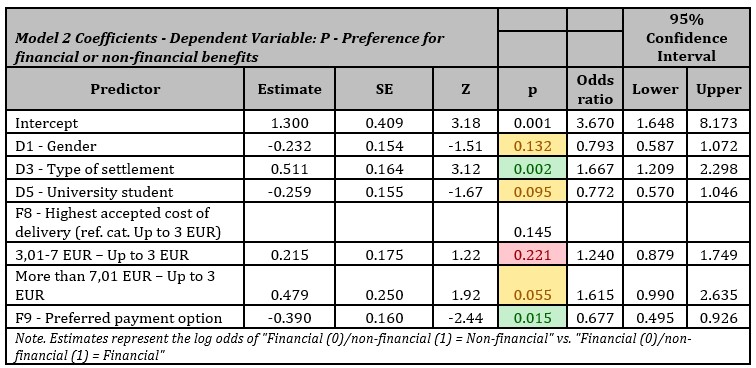
(Source: prepared by authors)
The results of the regression analysis of model 2 are presented in tab. 5.; while statistically significant values are highlighted in green, insignificant values are in yellow and red. We will only interpret statistically significant independent variables.
Independent variable D3 – Type of settlement is a statistically significant predictor p < 0.002, odds ratio = 1.667. Rural people prefer the financial benefits of online shopping more than urban people. Rural people are 1.7 times more likely to prefer the financial benefits of online shopping than urban people.
Independent variable F9 – Preferred payment option is a statistically significant predictor p < 0.002, odds ratio = 1.667. People, who prefer cash on delivery to other types of payment, prefer more non-financial benefits of online shopping. People who prefer other types of payment over cash on delivery have a 1.4 times (1/0.7=1.4) higher chance of preferring the financial benefits of shopping on the Internet.
Discussion and Conclusion
This article aims to determine the factors influencing certain aspects of consumer behavior when shopping on the Internet using the logistic regression method. We created two research models to achieve this goal.
By this research, we uniquely contributed by identifying the influence of specific factors or groups of customers on consumer behavior when shopping on the Internet. We created models where we tested the area of reputation management, more closely determined by customer reviews, and in the second model, the advantages of shopping online compared to shopping in a brick-and-mortar store. This research helps online sellers to create a more adjusted and specialized approach which allows them to target specific customers with a unique approach. They are discussed below. We analyzed in the first model which factors (independent variables) predict the dependent variable importance of customer reviews when making a purchase decision by online shopping. After obtaining initial results, we identified the independent variables that were statistically insignificant. We then tried creating several models and compared them to each other (based on BIC, AIC, and Nagelkerke R Square values) to find the optimal model with the independent variables. We excluded the following independent variables from model 1 in this analysis: D2 – Age, D3 – Type of settlement, D6 – Decision-making position in the family about purchases of basic products, and F3 – Preference for financial or non-financial benefits. The obtained model explains about one-fifth of the variability of the dependent variable. We proceeded to the analysis of the resulting model shown in tab. 4 subsequently. We found that men are less likely than women to consider customer reviews important, the same applies whether they are a university student or not, where university students are 1.9 times less likely to consider other customer reviews as important. When identifying with the statement that most characterizes the respondent, people who chose the following: “I usually choose a product online and then buy it in a brick-and-mortar store” have a 2x higher chance of considering customer reviews as important. This also confirms our assumptions, where we expected such a probability due to the fact that such people will try to use as many information resources as possible that the Internet offers for the needs of purchasing decisions. By another independent variable, people who shop on e-marketplaces are more likely, than non-shoppers, to consider customer reviews as important. This also aligns with our assumptions. A possible explanation for this could be that e-marketplaces greatly encourage the use of customer reviews and also display them directly with the goods. By the next statistically significant predictor F5 – The most trust-inspiring e-shop function, we can state that people who consider the customer reviews the most trustworthy element of a website have up to 4.7 times a higher chance of considering the customer reviews as important when making a purchase decision. This is also in line with our assumptions since the formulation of the independent and dependent variable already indicates a connection. The last independent variable F6 – Comparison of similar products from different sellers before purchasing also predicts the effect on the dependent variable. People who compare similar products at different sellers before making a purchase are less likely to consider customer reviews important.
We proceeded with the second model in the same way as the first. We investigated the factors that predict the dependent variable preference for financial or non-financial benefits of e-commerce. In this model, after the initial analysis, we excluded statistically insignificant independent variables D2 – Age, D4 – Education, D6 – Decision-making position in the family about purchases of basic products, F4 – Purchase on electronic marketplaces, F6 – Comparison of similar products from different sellers before purchasing, and F7 – Preferred delivery option. The newly created model interprets relatively little variability of the dependent variable (the original model reached similar values). We identified D3 – Type of settlement and F9 – Preferred payment option as statistically significant independent variables. In the first variable, we found that people in rural areas have a 1.7 times higher chance of preferring the financial benefits of online shopping than people from urban areas. This could be explained by the fact that people in cities earn more on average than people in the countryside. In the second independent variable, it can be concluded that people who prefer other types of payment over cash on delivery have a 1.4 times higher chance of preferring the financial benefits of shopping on the Internet.
There are several practical and managerial implications. Firstly, specific groups of customers (men vs women, groups created according to their trust to reviews, etc.) differ in their view at usefulness of reviews and their purchasing behavior is therefore different. Adjusted, targeted, and specialized approach to these groups from online sellers could generate higher impact. Secondly, financial benefits are valued by different groups such as customers from cities and customers from rural areas and other groups differently. Here again a more targeted and specialized approach to customers applied by online sellers could in broader sense generate higher sales. The topic of consumer purchasing behavior in the field of e-commerce is a relatively often analyzed area among many authors (Alhaimer, 2022), and its importance for practice is very high even because of the currently still ongoing COVID19 pandemic.
There are several limitations of our study. Firstly, our sample is consisting only in Slovak people; therefore, general transferability to other countries without concern is questionable. Secondly, our sample is not representative, with a higher portion of young people and many of them have university education, which also limits the generalization of our results. These limits could be addressed by researchers in future research, to confirm our findings and to create a picture of customers’ behavior in different cultures.
Our article was created within the project which aims to promote procedures in the field of methodology and methods of scientific research in management. One way to achieve this goal is to use the open-source statistical software JAMOVI in scientific research, due to its free availability and ease to use.
Acknowledgments
This research was supported by a grant from the Slovak Ministry of Education, Science, Research and Sport, KEGA 016EU-4/2021: Innovation of the study program through the development of a new modern university textbook entitled: Methodology and methods of scientific research in management, with supporting teaching aids.
References
- Chrysostome, E., and Rosson, P., (2009). The internet and SME internationalisation: Promises and illusions. Journal for International Business and Entrepreneurship Development, 4 (1-2), 107.
- Statista, (2022). Retail e-commerce sales worldwide from 2014 to 2025 [Online], [Retrieved September 09, 2022], https://www.statista.com/statistics/379046/worldwide-retail-e-commerce-sales/.
- Bravo, R., Gonzalez Segura, M., Temowo, O., and Samaddar, S., (2022). How Does a Pandemic Disrupt the Benefits of eCommerce? A Case Study of Small and Medium Enterprises in the US. Journal of Theoretical and Applied Electronic Commerce Research, 17 (2), 522–557.
- Stair, R., Reynolds, G., and Chesney, T., (2018). Principles of business information systems. United Kingdom : Cengage, 2018, ISBN: 978-1-4737-4841-5.
- Černý, M. et al., (2021). The Attractiveness of Investing in E-commerce in Terms of Developing Customer Behavior when Shopping Online. In Business Information Management Association Conference. Innovation Management and Sustainable Economic Development in the Era of Global Pandemic (IBIMA) : Proceedings of the 38th International Business Information Management Association Conference. – Norristown : International Business Information Management Association, 3486-3495.
- Hashem, T. N. (2020). Examining the influence of COVID 19 pandemic in changing customers’ orientation towards e-shopping. Modern Applied Science, 14(8), 59-76
- Sayyida, S., Hartini, S., Gunawan, S., & Husin, S. N. (2021). The Impact of the Covid-19 pandemic on retail consumer behavior. APTISI Transactions on Management, 5(1), 79-88.
- Koch, J., Frommeyer, B., & Schewe, G. (2020). Online shopping motives during the COVID-19 pandemic—lessons from the crisis. Sustainability (Switzerland), 12(24), 1-20.
- Gartner, (2022). Reputation Management (Glossary) [Online], [Retrieved September 09, 2022], https://www.gartner.com/en/marketing/glossary/reputation-management/.
- Halim, E., Wardhana, G., and Sasongko, A. H., (2022). Online Customer Reviwes as a Marketing Tool to Generate Customer Purchase Intention in Ecommerce, 2022 IEEE International Conference on Cybernetics and Computational Intelligence (CyberneticsCom), 28-33.
- Ma, X. Li, B., and Bai, R., (2020). Do you respond sincerely? how sellers’ responses to online reviews affect customer relationship and repurchase intention, Frontiers of Business Research in China, 14 (1).
- Rose, M., and Blodgett, J. G., (2016). Should hotels respond to negative online reviews? Cornell Hospitality Quarterly, 57(4), 396–410.
- Moriuchi, E., (2018). “Is that an honest online review? the effectiveness of disclaimers in online reviews”, Journal of Marketing Theory and Practice, 26 (3), 309-327.
- Flanagin, A. J., Metzger, M. J., Pure, R., and Markov, A. (2011). User-Generated Ratings and the Evaluation of Credibility and Product Quality in Ecommerce Transactions, 44th Hawaii International Conference on System Sciences, 1-10.
- Kidane, T. T., and Sharma R. R. K., (2016). Factors Affecting Consumers’ purchasing Decision through E-Commerce. International Conference on Industrial Engineering and Operations Management, 159-165.
- Filieri, R., Mcleay, F., Tsui, B., and Lin, Z. (2018). Consumer perceptions of information helpfulness and determinants of purchase intention in Audencia Business School, online consumer reviews of services. Information management, 55 (8), 956-970.
- Thomas, M., Wirtz, B. W., and Weyerer, J. C. (2019). Determinants of online review credibility and its impact on consumers` purchase intention. Journal of Electronic Commerce Research, 20 (1).
- Moon, J., Choe, Y., & Song, H. (2021). Determinants of consumers’ online/offline shopping behaviours during the COVID-19 pandemic. International Journal of Environmental Research and Public Health, 18(4), 1-17.
- Odilia, G., Sulistiobudi, R. A., & Fitriana, E. (2022). Factors Contributing to Online Shopping Behavior During Covid-19 Pandemic: The Power Of Electronic Word Of Mouth In Digital Generation. Academy of Entrepreneurship Journal, 28, 1-10.
- Childers, T.L., Carr, C.L., Peck, J., and Carson, S.J. (2001). HEDONIC AND UTILITARIAN MOTIVATIONS FOR ONLINE RETAIL SHOPPING BEHAVIOR. Journal of Retailing, 77, 511-535.
- Forsythe, S., Liu, C., Shannon, D. and Gardner, L. (2006). Development of a Scale to Measure the Perceived Benefits and Risks of Online Shopping. Journal of Interactive Marketing, 20, 55 – 75.
- Santana, S., and Loureiro, S. (2010). Assessing benefits and risks of online shopping in Spain and Scotland. Portuguese Journal of Management Studies, 15(2), 161-172.
- Arora, N., and Aggarwal, A. (2018). The role of perceived benefits in formation of online shopping attitude among women shoppers in India. South Asian Journal of Business Studies.
- Ameen, N., Tarhini, A., Shah, M. H., & Nusair, K. (2021). A cross cultural study of gender differences in omnichannel retailing contexts. Journal of Retailing and Consumer Services, 58, 102265.
- Wijaya, A., Grace, E., Candra, V., & Sidabutar, N. (2022). Examining The Effect Of Consumer Demographic Characteristics On Online Or Offline Shopping Preference. International Journal of Science, Technology & Management, 3(1), 196-201
- Narges, D., Laily, H. P., Sharifah, A. H., Samsinar, M. S., and Ali, K. (2009). Factors affecting students attitude toward online shopping. African Journal of Business Management, 3(5), 200-209.
- Bellman, S., Lohse, G., and Johnson, E. (1999). Predictors of online buying behavior, Communications of the ACM, 42 (12), 32–38.
- Alkan, Ö., and Ünver, Ş. (2021). DETERMINATION OF FACTORS THAT AFFECT USE OF E-COMMERCE IN EASTERN TURKEY THROUGH CATEGORICAL DATA ANALYSIS. Special Issue on International Symposium of Sustainable Logistics, 22-36
- Riad, E., and Al Chami, R. (2021). Consumer Behavior Decision Making prior to Shopping Online “Why E-commerce is not working for Lebanese”. International Journal of Management and Commerce Innovations, 6, 58-71.
- Delafrooz, N., Paim, L. H., and Khatibi, A. (2009). Developing an instrument for measurement of attitude toward online shopping. European Journal of Social Sciences, 7(3), 166-177.
- Rabušic, L., Soukup, P., and Mareš, P. (2019). Statistická analýza sociálněvědních dat (prostřednictvím SPSS), 573. ISBN 978-80-210-9248-8
- Alhaimer, R. (2022). Fluctuating attitudes and behaviors of customers toward online shopping in times of emergency: The case of Kuwait during the COVID-19 pandemic. Journal of Internet Commerce, 21(1), 26-50.









